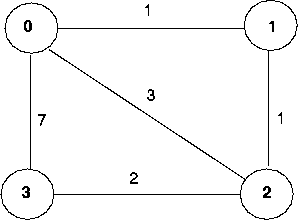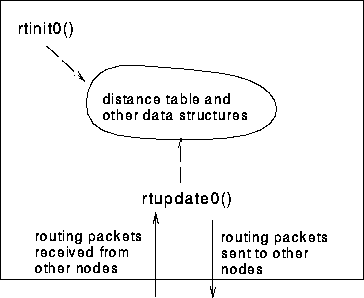
Figure 1: Network topology and link costs for DV
routing lab
In this program assignment, you will be writing a "distributed" set of procedures that implement a distributed asynchronous distance vector routing for the network shown in Figure 1.

Figure 1: Network topology and link costs for DV
routing lab
The routines you will write for the assignment, you are to write the following routines which will ``execute'' asynchronously within the emulated environment that we have written for this assignment.
For node 0, you will write the routines:
rtupdate0() is the "heart" of the distance vector algorithm. The values it receives in a routing packet from some other node i contain i's current shortest path costs to all other network nodes. rtupdate0() uses these received values to update its own distance table (as specified by the distance vector algorithm). If its own minimum cost to another node changes as a result of the update, node 0 informs its directly connected neighbors of this change in minimum cost by sending them a routing packet. Recall that in the distance vector algorithm, only directly connected nodes will exchange routing packets. Thus nodes 1 and 2 will communicate with each other, but nodes 1 and 3 will node communicate with each other.
As we saw in class, the distance table inside each node is the principal data structure used by the distance vector algorithm. You will find it convenient to declare the distance table as a 4-by-4 array of int's, where entry [i,j] in the distance table in node 0 is node 0's currently computed cost to node i via direct neighbor j. If 0 is not directly connected to j, you can ignore this entry. We will use the convention that the integer value 9999 is ``infinity.''
Figure 2 provides a conceptual view of the relationship of the procedures inside node 0.
Similar routines are defined for nodes 1, 2 and 3. Thus, you will write 8 procedures in all: rtinit0(), rtinit1(), rtinit2(), rtinit3(),rtupdate0(), rtupdate1(), rtupdate2(), rtupdate3()

Figure Lab 2: Relationship between procedures inside node
0
The procedures described above are the ones that you will write. The following routines that can be called by your routines have been written as follows:
extern struct rtpkt {
int sourceid; /* id of node sending this pkt, 0, 1, 2, or 3 */
int destid; /* id of router to which pkt being sent
(must be an immediate neighbor) */
int mincost[4]; /* min cost to node 0 ... 3 */
};
Note that tolayer2() is passed a structure, not a pointer to a
structure.
Your procedures rtinit0(), rtinit1(), rtinit2(), rtinit3() and rtupdate0(), rtupdate1(), rtupdate2(), rtupdate3() send routing packets (whose format is described above) into the medium. The medium will deliver packets in-order, and without loss to the specified destination. Only directly-connected nodes can communicate. The delay between is sender and receiver is variable (and unknown).
When you compile your procedures and my procedures together and run the resulting program, you will be asked to specify only one value regarding the simulated network environment:
A tracing value of 2 may be helpful to you in debugging your code. You should keep in mind that real implementors do not have underlying networks that provide such nice information about what is going to happen to their packets!
You are to write the procedures rtinit0(), rtinit1(), rtinit2(), rtinit3() and rtupdate0(), rtupdate1(), rtupdate2(), rtupdate3() which together will implement a distributed, asynchronous computation of the distance tables for the topology and costs shown in Figure 1.
You should put your procedures for nodes 0 through 3 in files called node0.c, .... node3.c. You are NOT allowed to declare any global variables that are visible outside of a given C file (e.g., any global variables you define in node0.c. may only be accessed inside node0.c). This is to force you to abide by the coding conventions that you would have to adopt is you were really running the procedures in four distinct nodes. To compile your routines: cc prog3.c node0.c node1.c node2.c node3. Prototype versions of these files are here: node0.c, node1.c, node2.c, node3.c. A copy of the file prog3.c is here.
This assignment can be completed on any machine supporting C. It makes no use of UNIX features.
You are expected to hand in a code listing, a design document, and sample output.
For your sample output, your procedures should print out a message whenever your rtinit0(), rtinit1(), rtinit2(), rtinit3() or rtupdate0(), rtupdate1(), rtupdate2(), rtupdate3() procedures are called, giving the time (available via my global variable clocktime). For rtupdate0(), rtupdate1(), rtupdate2(), rtupdate3() you should print the identity of the sender of the routing packet that is being passed to your routine, whether or not the distance table is updated, the contents of the distance table (you can use my pretty-print routines), and a description of any messages sent to neighboring nodes as a result of any distance table updates.
The sample output should be an output listing with a TRACE value of 2. Highlight the final distance table produced in each node. Your program will run until there are no more routing packets in-transit in the network, at which point our emulator will terminate.
Requirements for Submission:
This is a group program assignment. Each group contains 2-3 people.
Each group must:
Submit one copy of source codes through myClass@Salisbury.edu
On the head of your source codes, clearly state
1. Student names in your group
2. You program running platform. How to Compile and Execute your program.
Hand in
1. Design/pseudocode/hierarchy chart of your algorithm.
2. A printed copy of your source codes.
3. Sample outputs
4. Program report:
a.
One group report:
(1) state clearly if your group has finished all required tasks for the program.
If your group doesn't finish the program or some part of that doesn't work, the
report must state clearly what the problem is. If you get
any help from other resources (eg. Internet), you need to give the reference
links. (2) Your group needs to records the group meeting times and hours. (3)
You may also tell the instructor in your report any interesting feature you have
implemented.
b.
One individual
report for each student: (1) what your individual task and accomplishment, (2)
how many hours and efforts each individual put on the program, (3) what most
difficult things you ever encounter and how you conquer them, (4) and what do
you learn from the program.
Grading Rubric:
Documentation of your program: 20
Comments/readability of program: 10
Workable Program 50
Demo of your program 20